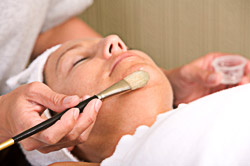Alpha Hydroxy Acids are a fascinating subject! AHAs are now an active ingredient in a lot of cosmeceutical ranges, and a common chemical peel. Glycolic acid is a popular Alpha Hydroxy Acid, and a popular beauty buzz-ingredient. AHAs are usually derived from natural sources (although can also be synthesised). Glycolic acid is from sugar cane. lactic acid from sour milk, Tartaric Acid is from grapes, malic from apples and citric from …well maybe you can guess that one.
How Alpha Hydroxy Acids work, is they dissolve the glue-like substance between skin cells, the very same that helps dead skin cells to stay put when the skin is dehydrated (this is why we can get flaky when dehydrated, because this glue holds dead skin cells together instead of them naturally shedding like in hydrated skin – our skin is strange, I know!). So, AHAs are an exfoliant.
There is also reported benefits such as stimulation of collagen and elastin. I can’t actually seem to find any hard evidence of this fact. What I think is much more plausible, is; with the exfoliation effect of an AHA, new skin is encouraged, i.e. it speeds up ‘cellular renewal’. What this does, it helps to encourage new, fresh, healthy and hydrated skin. This healthier skin will also create collagen and elastin much more efficiently, hence the beneficial anti-ageing results associated with AHA. The biggest thing that distinguishes AHAs and BHAs, is, apart from salicylic acid being the only BHA, AHAs are water-soluble, wheras BHAs are lipid-soluble (which I will explain in better detail in my next article)
Even though Alpha Hydroxy Acids are considered the ‘lightest’ form of chemical peel, they can have a considerable visual effect on fine wrinkles, surface congestion, dehydration and pigmentation (most effective with pigmentation closer to the surface of the skin. Deeper pigmentation is very hard to shift – often deep skin laser treatments like Fraxel laser are the only effective treatments for deep pigmentation)
AHA peels are widely accessible, and are much more safe than some cosmetics ‘active’ ingredients. They are widely recommended to be using on a regular basis, as home care. Their effectiveness is determined by their pH, and their ‘bioavailability’ – basically what that means is, the smaller the molecular size, the further it will penetrate down into the epidermis (the outer layer of the skin), making it more effective. Glycolic acid has the best bioavailability, hence it’s popularity.
Many skin salons offer AHA peels, often recommending a series of treatments for optimal results. Most skins are compatible with AHAs, adverse reactions aren’t so common. In home-safe percentages (5-10%), reactions like persistent irritation, redness and flaking are not common, but possible. In higher, salon, or dermatologist concentrations, some adverse effects can also include hyper-pigmentation (as it can penetrate too far and flare up the melanocytes – which are responsible for tanning. When they are inflamed, they are activated. Instead of making a nice even tan, they present themselves in blotches, hence pigmentation forms). The pH of the AHA applied also affects the severity of the effect (which can inflate adverse reactions too) – the more further from the skin’s natural pH, the more possible it is for a reaction.
There are some AHA home-care skin cleansers, although their effectiveness is debatable, because AHAs need a few minutes to activate on the skin. There are plenty of AHA moisturisers, this is the most effective form of ongoing delivery at home. AHAs are not mixed with sunscreens, as the pH required for AHA to be effective makes sunscreen’s active ingredients unstable. All skins need sunscreen, but particularly those treating their skin with AHA, as it can increase photosensitivity – all that fresh new skin is also very sensitive to light! It’s baby-fresh!
Personally, I would recommend a course of AHA peels as a refresher for dull, lacklustre skin. The results are noticeable and instant. What I don’t recommend however, is continued, ongoing use (contrary to other opinions I’ve seen around on the web). It’s great for a one-off boost, because it boosts exfoliation and cell turnover in your skin, but is this something you want to get your skin used to? The other issue is, as AHAs can be an irritant, forcing your skin to create ‘new’ skin, through it’s own wound-healing process. Overuse could end in sensitivity issues, and reactive skin. Another adverse effect of ongoing use is the skin’s pH – or natural ‘acid mantle’ protective barrier can become compromised, causing a stripped, unbalanced skin. This can cause breakout issues – when the natural barrier of the skin breaks down, it goes into overdrive, making more oil to compensate. Combined with dehydrated, stripped skin, this extra oil wreaks havoc – inevitably causing breakout.
But don’t be scared, Alpha Hydroxy Acid might be a scary sounding word, but, being mostly derived from natural sources, AHAs are kind to most skins, and give great results!
Related articles
- Break-it-down: Glycolic Acid (nerd alert!) (facetedbeauty.wordpress.com)
- exfoliation – the key to glowing skin? (theafrobeauty.com)


Pingback: skin renewal: Age Revers Face Cleanser 6 oz. 6 Liquids
Pingback: skin renewal: Pharmagel HydrO2xy-10 Lifting and Firming Concentrate 8oz
Currently it seems like WordPress is the best blogging platform out there right now.
(from what I’ve read) Is that what you’re using on your blog?
Hi there, yes I use WordPress, it’s great —and very easy to use